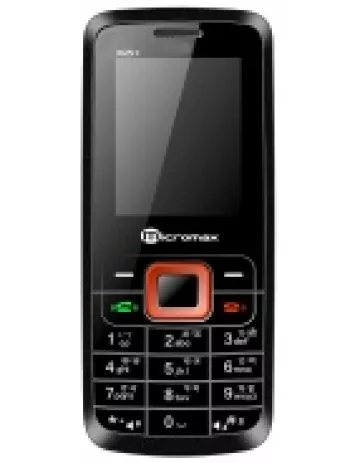
Introduction to Micromax A88
The Micromax A88, released in 2013, was designed to target the budget-conscious segment of smartphone users. With its competitive features such as a dual-core processor, decent camera capabilities, and a modest battery life, it was quite popular within its target market. Despite its discontinuation, the A88 remains a noteworthy example of Micromax's contribution to affordable technology during its era.
Network Capabilities
The Micromax A88 is equipped with GSM / HSPA technology, enabling it to support a range of network bands. For 2G bands, it operates on GSM 900 / 1800 frequencies for both SIM cards as it features a dual SIM (Mini-SIM) setup, providing users with the convenience of managing two numbers simultaneously. It also supports the HSDPA 2100 band for 3G connectivity, offering speeds capable of handling basic internet browsing and data services that were sufficient for users' needs at the time.
Design and Build
In terms of design, the Micromax A88 measures 135 x 68.7 x 11.3 mm. The sleek build, paired with its lightweight design, made it easy to handle and hold. While the exact weight isn't specified, its compact size and dual color options of black and white contributed to its aesthetics and appeal. The inclusion of a dual SIM setup meant users could switch between two networks seamlessly, a feature that was particularly useful in regions where network coverage varied.
Display Features
Furnished with a 4.5-inch TFT display, the Micromax A88 boasts a screen-to-body ratio of approximately 60.2%, with a resolution of 480 x 854 pixels. This results in a pixel density of around 218 ppi, offering satisfactory visual clarity for tasks like web browsing and media consumption. Although not as advanced as the displays we see today, it was adequate for the mid-range smartphones of its time.
Performance Specifications
The Micromax A88 runs on Android 4.1.1, also known as Jelly Bean, powered by the Mediatek MT6577 chipset with a dual-core 1.0 GHz Cortex-A9 CPU. Accompanied by a PowerVR SGX531u GPU, the smartphone delivered basic graphical performance, suitable for standard applications and light gaming. With 512MB of RAM, multitasking was limited compared to modern standards, but it managed everyday activities effectively.
Memory and Storage
Internally, the Micromax A88 offers 4GB of storage, of which around 2GB is user-accessible. Considering the requirements of apps and media at its launch, this was modest. However, the option of expandable storage via a dedicated microSDHC slot allowed users to increase available space, providing essential flexibility for music, videos, and other content storage.
Camera Quality
The main camera of the Micromax A88 is a 5 MP shooter with autofocus capabilities and a dual-LED flash, providing well-lit images in low-light conditions. Video recording is available at 720p, enabling users to capture memories with reasonable detail. A secondary camera, although unspecified in resolution, was included for basic selfie capturing and video calling needs.
Audio and Connectivity
The audio department in the Micromax A88 consists of a loudspeaker and a 3.5mm headphone jack. It supports FM radio, a prized feature among users who enjoy live radio broadcasting. For connectivity, the phone includes Wi-Fi 802.11 b/g/n with hotspot capabilities, Bluetooth 4.0 with A2DP for wireless connections, GPS for navigation, and microUSB 2.0 for charging and data transfer.
Sensor and Battery Life
Sensors in the Micromax A88 include an accelerometer and proximity sensor, serving various functionalities like automatic screen rotation and call-related features. Its battery is a removable Li-Ion 1800 mAh unit, offering up to 260 hours of standby time and about 5 hours of talk time. This capacity allowed users to effectively manage a full day of moderate usage without extreme reliance on constant charging.
Pricing and Conclusion
At launch, Micromax A88 was priced at approximately 110 EUR. This competitive pricing, combined with its feature set, made the smartphone an attractive option for budget-conscious consumers looking for a reliable, functional smartphone. Although discontinued, the A88 remains a testament to Micromax's strategy of offering reasonable technology at affordable prices, catering to a wide range of users, particularly in emerging markets where the cost of technology remains a significant factor.
Key Features of Micromax A88
- Supports Dual SIM (Mini-SIM)
- Runs on Android 4.1.1 (Jelly Bean)
- Equipped with a MediaTek MT6577 chipset and Dual-core 1.0 GHz Cortex-A9 CPU
- 4.5-inch TFT display with a resolution of 480 x 854 pixels
- Expandable storage via microSDHC card slot
- 5 MP main camera with autofocus and dual-LED flash, capable of 720p video recording
- Comes with a 3.5mm headphone jack and FM radio
- Connectivity options include Wi-Fi 802.11 b/g/n, Bluetooth 4.0, and GPS
- Removable Li-Ion 1800 mAh battery providing up to 260 hours standby and 5 hours talk time
Drawbacks of Micromax A88
- Lack of 4G connectivity, limited to 3G network.
- Old Android version (Android 4.1.1 Jelly Bean) with no updates available.
- Low internal storage capacity of 4GB, with only 2GB available for users.
- Limited RAM of 512MB, which may affect multitasking performance.
- Weak processor (Dual-core 1.0 GHz Cortex-A9) may result in sluggish performance.
- Low display resolution of 480 x 854 pixels.
- Basic 5 MP rear camera with average picture quality and lack of advanced features.
- No NFC support for contactless payments.
- Short talk time of up to 5 hours due to limited battery capacity.
- Discontinued product, meaning no official support or repair services available.

View Also
More Phones
All Rights Reserved +14266 Phones © Mobilawy 2025

























